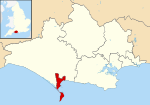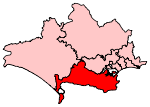HMS Sarepta
Royal Naval Air Stations in EnglandUse British English from January 2017
RNAS Portland was an air station of the Royal Navy from 1917. The site was first built in 1917 as HMS Sarepta within the confines of Portland Harbour as a seaplane base; the aircraft operating from the base's slipways. In 1959 it became RNAS Portland (HMS Osprey)
Excerpt from the Wikipedia article HMS Sarepta (License: CC BY-SA 3.0, Authors).HMS Sarepta
Mulberry Avenue,
Geographical coordinates (GPS) Address Nearby Places Show on map
Geographical coordinates (GPS)
| Latitude | Longitude |
|---|---|
| N 50.568888888889 ° | E -2.4505555555556 ° |
Address
RNAS Portland
Mulberry Avenue
DT5 1FT , Portland
England, United Kingdom
Open on Google Maps







